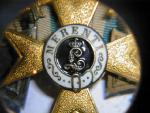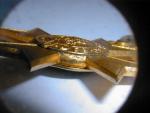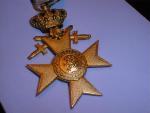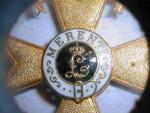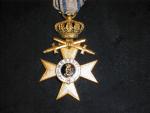
Ed Maroli
For Deletion-
Posts
223 -
Joined
-
Last visited
Content Type
Profiles
Forums
Blogs
Gallery
Events
Store
Everything posted by Ed Maroli
-
I'm glad to see Ulstermans MVKI is authentic. I'm willing to accept mine as a an upgraded MVK2. I just can't see the difference between my piece with a gilded silver medallion and the Type 3 Leser with the gilded silver medallion. I do believe the experts on this forum because my knowledge is quite limited with the MKVI. What am I to look for? Should I get the salt bath ready? ~ED
-
Huge blow to New Zealand
Ed Maroli replied to Chris Boonzaier's topic in Great Britain: Orders, Gallantry, Campaign Medals
Here is his punishment from his appeal. ~Ed http://www.ca6.uscourts.gov/opinions.pdf/06a0286p-06.pdf -
Huge blow to New Zealand
Ed Maroli replied to Chris Boonzaier's topic in Great Britain: Orders, Gallantry, Campaign Medals
I know this is long, but read this and understand why things should never go to museums. WRIGHT-PATTERSON AIR FORCE BASE | By thievery, carelessness, or both, America is losing artifacts of its aviation heritage. The United States Air Force Museum once stored the aging wooden pattern used to cast the engine that enabled aviation pioneers Wilbur and Orville Wright to achieve the first powered flight in 1903. It's missing. Ten artifacts, ranging from camp regulations to a notebook, entrusted to the museum from survivors of World War II prisoner-of-war camps. Also missing. Bombs, bomb fuses, guns, a "urine collection device" from the Apollo program and a camera lens from the Gemini space program. Missing as well. A March 21, 2002, audit of the museum by the Wright-Patterson Area Audit Office, obtained by the Dayton Daily News, reported that 1,000 items could not be located. Auditors concluded the museum's personnel "did not always effectively manage museum property." It's not just carelessness, it's theft, said Albert Harris Jr., a former museum worker who says he was punished when he blew the whistle. "We witnessed, we watched it, we complained about it," said Harris, who now works at the base library. "Thousands of artifacts are missing." Investigators dismissed Harris' early complaints. But a later probe led to the federal indictment this year of the museum's former chief of collections, charged with selling an armored vehicle that he knew had been stolen from the museum. The artifacts' disappearance from the Air Force Museum, the world's oldest and largest military aviation museum with 2 million visitors a year, is coming to light as the community celebrates 100 years of aviation history and the museum is erecting huge new buildings to hold its burgeoning collection. Maj. Gen. Charles Metcalf, the museum's director, said the number of missing items has been reduced to 510. Noting the museum maintains more than 57,000 items, Metcalf says, "This is a low error rate for a collection this size." But numbers alone don't tell the story. Ken Hyde of Warrenton, Va., recalled borrowing the engine pattern for the Wright Flyer several years ago to make three engines, including one he placed in his reproduction of the 1903 Wright Flyer. "They're priceless," Hyde said of the missing items. According to the museum, the engine mold was deaccessioned (removed from active inventory) to a restoration collection in 1997, and was reported missing in January 2001. Donald E. Kirby, 81, of Columbus, said the missing prisoner-of-war items represented the men and women who were reduced to German property. "I think any child looking at that would at least think that was kind of important," said Kirby, who was held in a German POW camp for 18 months during World War II. "That (artifact) was the person right there." The official list of missing items also appears incomplete. Three Russian-made 23 mm anti-aircraft cannons that auditors reported missing in March 2002 are not on the list. "These guns have not been located," the museum confirmed, and "in all probability were turned into the Defense Reutilization/Marketing Office. . . . However, full documentation has not been found to support this action." Nine other weapons that auditors could not account for also remain missing, according to the museum, and the effort to identify them "has been inconclusive." The list also does not include the the Wright brothers' engine pattern. Also confirmed missing, but not on the list, is a reproduction of the Congressional Gold Medal awarded to the Wright brothers in 1909. The original medal is at Wright State University. Metcalf conceded that missing deaccessioned items, such as the Wright brothers' engine pattern and medal, are not included among the 510 missing items. Asked how many items might be missing among the deaccessioned, Metcalf replied, "We don't have a clue," citing unreliable paperwork. "Two days ago, we found items that had been missing and they had been shipped to a museum in Michigan and they're there," he said in a recent interview. "But the records have not been updated." Rules in place, but not followed The audit is not the first of its kind. A June 5, 1996, audit report determined "museum personnel did not adequately manage the acquisition, registration and documentation of weapons" or "establish accountability of historical property within 24 hours of receipt." The 2002 audit says the person most responsible for the missing items is the museum's former chief of collections, whom auditors said disposed of museum property while bypassing required oversight. Scott A. Ferguson, the former chief of collections, is under indictment in U.S. District Court, charged with selling an armored vehicle in 1999, knowing it had been stolen from the museum in 1996. "It's quite obvious if you have a leak at that level, you could lose your shirt before you knew it," retired Air Force Col. Richard L. Uppstrom, the museum's civilian director from 1985 to 1996, said of the indictment. The audit cites an Air Force instruction, signed by Metcalf on Nov. 25, 1996, that states, "No donated items of historic property of any type (hardware, documentation, photographic, etc.) will be disposed of in any manner without first being reviewed by the division responsible for the items and approved for disposition by the Deaccession Committee. "After Deaccession Committee approval, the director and curator must both sign an Inventory Adjustment Voucher (IAV) prepared by Collections Division personnel," the instruction notes. Asked about claims that the committee had not met for years prior to the 2002 audit, Metcalf replied that the committee "is not a 'committee' in the traditional sense. It is a body of individuals who provide recommendations and oversight of proposed deaccessions through a formal coordination process. "Though this process has been in place dating back to at least November 1996, records of committee coordination prior to 2001, during the tenure of the previous collection chief (Ferguson) do not exist. Paperwork indicates deaccessioned items did not go through proper approval process, having been signed off unilaterally by the collection chief responsible at the time." Chief of collections had little supervision A list prepared by the museum shows thousands of items, ranging from jackets and ribbons to trucks and aircraft, were deaccessioned during Ferguson's tenure. Any records regarding oversight of this process, if they existed, are nowhere to be found. The chief of collections operated without much supervision, the auditors noted. Their review of 123 inventory adjustment vouchers, used to document removal of museum property, found that 122 lacked proper authorization and documentation, with some "signed by unauthorized personnel." The lack of proper documentation, auditors concluded, "occurred because the chief of collections did not follow established guidance and procedures for the disposition of historical property. "This situation went undetected because USAFM (Air Force Museum) personnel had not established procedures for periodic internal reviews of deaccession transactions. "Specifically," auditors noted, "the chief of collections could unilaterally complete and authorize IAVs, complete transfer papers, package items for disposition and record association inventory adjustments." Auditors make no specific mention of Metcalf or what he did to enforce the 1996 instruction he signed regarding removal of museum inventory. The museum, in a written response to questions from the Daily News, concedes that "responsible management procedures and policies have always been in place, but unfortunately not always followed. When reviews indicated that problems existed, the museum took proper action by requesting the investigations and audits that ultimately led to the current criminal charges." Since 2001, Metcalf said, the deaccession process "has been stringently adhered to" and now requires quarterly review by the Materiel Command History Office. The museum denied the Daily News access to the museum's records, saying that releasing information regarding the identity of people who obtained museum property would violate the Privacy Act. Soon after he became director in December 1996, Metcalf said in an interview, he ordered Ferguson to "cease and desist" from selling military items at gun and militaria shows. Militaria are military collectibles, whose collectors buy everything from radiation detectors and Marine swords to gas masks, Civil War bullets, armored vehicles and aircraft. Metcalf said he also told Ferguson that he "wanted him to disassociate himself" from a man who often exchanged items with the museum and was a museum contractor. "It was one of those relationships, even if it was good, that gave you the perception of not good," Metcalf said. Whistleblower reduced to washing hospital dishes Then came warnings from Albert Harris Jr., a former materials handler at the museum who says the reported losses, often from thefts, don't begin to scratch the surface. The U.S. Office of Special Counsel (OSC) confirms Harris reported his suspicions about Ferguson in 1997 ? Harris said it was as early as 1993 that he reported his suspicions of thefts to his supervisor. The OSC is an independent federal investigative and prosecution agency that protects federal employees from reprisal for whistleblowing. Harris said that shortly after he was interviewed by the Office of Special Investigations (OSI), the Air Force's major investigative service, he was retaliated against when his position was eliminated. Harris said he was reduced to washing dishes at the base hospital after he claimed to investigators that Ferguson was involved in the thefts. In addition to thefts of artifacts at the museum, Harris said he saw people cart off, before they were logged into the museum's inventory, artifacts shipped to the museum from satellite museums during base closings. The museum confirmed that "logs have been and are being compared and inconsistencies are being resolved" regarding this claim. Highly collectible items go missing In an Oct. 3, 2001, statement to the OSI, Harris described several incidents involving museum property. Harris stated, for example, that on a late Friday afternoon sometime around 1996, Ferguson asked him to help him remove an M-60 machine gun mounted on a helicopter because Metcalf said historically it didn't belong on that copter. After they removed the M-60, Harris said, Ferguson "told me that it was late and he was not going to the vault (where guns are stored) and he put the M-60 in his office." Harris said it hasn't been seen since. Metcalf confirmed Aug. 14 that he ordered the gun removed, but had not heard Harris' claim of it being placed in Ferguson's office "until five days ago." Harris, however, reported this in his Oct. 3, 2001, statement to OSI investigators. A museum restoration employee, who asked not to be identified, said he saw Ferguson and Harris remove the machine gun from the helicopter and thought it strange because this was work normally "done by the restoration division." Metcalf said it was not possible to determine if the M-60 removed from the helicopter is the same one that's missing because "there is no register of what gun was taken out of the vault and put on" the helicopter. "We don't know what that (M-60) went on, don't know what it came off because the paperwork was not prepared in collections," Metcalf said. A source close to Ferguson, who asked not to be identified, said the M-60 is now mounted on an armored vehicle at the museum. Metcalf conceded the paper trail created by Ferguson's office is often completely unreliable. Paperwork has shown items removed from inventory that are still in the museum. Other records show "things that were certified as destroyed and they were exchanged with a foreign government," Metcalf said. And he pulled out a document to show some paperwork is postdated ? recording, years after it occurred, a truck's disposal. "The people who work in collections, along with the senior leadership, absolutely feel violated," Metcalf said. The museum was violated as well, Harris said. On one occasion, Harris said, he and another employee visited the "vault" where guns, swords, knives and other items are stored. "It looked like a hurricane hit it," Harris said. "I was shocked. Stuff was pulled out all over the floor." Among items missing from the museum are guns, swords and knives ? items normally stored in the museum's vault. Harris said drawers full of pins and medals also disappeared: "They were authentic. Not that replica crap." Authentic World War II Nazi and Allied memorabilia, Harris said, are in high demand at gun and militaria shows. Harris said OSI investigators didn't bother to accompany him to the scenes of the disappearances when he reported them. Metcalf said the OSC probe "found no correlation between the disclosure about Scott Ferguson and any adverse action" against Harris. The museum eliminated three positions and "appropriate personnel procedures were followed to place Mr. Harris in a position for which he qualified," Metcalf said. Claims of thefts deemed 'insufficient' The OSC probe cleared Ferguson in 1999 of Harris' claims of theft. That was about the time Ferguson was selling an armored vehicle that a grand jury's indictment said was stolen in 1996 from the museum. "To our knowledge, the investigations were complete," Metcalf said in a written response to Daily News questions. Travis Elliott, the OSC's acting director for congressional and public affairs, said the OSC inquiry determined only whether Harris' claims should be investigated. He said the OSC determined that they were insufficient to warrant such a probe. "The allegations have to be specific and sufficient in order for us to refer it for investigation," Elliott said. In a letter dated July 8, 1999, the OSC advised Harris that Ferguson had been cleared of "your allegations of theft" and that Harris was not entitled to whistleblower protection. "Although you may have had a reasonable belief that at the very least Mr. Ferguson was not following agency regulations for the transport of museum artifacts, the evidence showed that you did not disclose your belief regarding the incidents in 1993 and 1994 to anyone until August 1997, after the decision was made to abolish your position," the letter states. The OSC conceded in the letter that Harris' position was abolished after he spoke with investigators. "Additionally, although the timing of the decision to surplus your position came relatively soon after your first OSI interview, there was no evidence that Mr. Ferguson was angry with you because you spoke to the OSI investigator, or that he believed you had accused him of theft," the letter states. The OSC also found Ferguson's discipline of Harris was reasonable. "Given the past problems you had with leave and overtime and the fact that Mr. Ferguson counseled you on the appropriate leave procedures to follow six days before the last AWOL charge, his action does not appear to be unreasonable or linked to any protected activity," the letter states. "The evidence showed that your problems with leave and overtime began as early as January 1997, before you had engaged in any protected activity (reported his suspicions)." Elliott said Harris can hire an attorney and file a case with the Merit Protection Board if he disagrees with the OSC determination. Harris said he is meeting with an attorney to see what action he can file. Harris said he committed no wrongdoing and his transfer left a clear message to other museum employees: "You cause trouble, you rock the boat, you follow Al," he said of himself. "And where did Al go? To the kitchen." ?A lot on our plate' Within months after Ferguson was cleared of Harris' claims in 1999, a researcher at the museum discovered some items missing and reported this to then-registrar Krysta Strider, who is now chief of collections. Strider said she reported the missing items to Metcalf. She said a voucher executed by Ferguson showed that 85 items ? helmets, daggers, pennants, goggles ? were sent to the National Air Intelligence Center. "We called the individual they were supposed to go to and he said he only had 11 items," Metcalf said. Metcalf said he ordered all 85 items returned by both Ferguson and the center. Asked if this happened other times, Metcalf replied, "Perhaps it did." As for why it took so long to discover irregularities related to Ferguson's records, Metcalf said, "We had a lot on our plate at that time." "In this hierarchy, I had a curator who was responsible for that (supervising Ferguson)," Metcalf said. "What's he doing? You have to rely on an organization to function." Once the curator was removed "out of the direct line," Metcalf said "the heat started increasing" and Ferguson "asked to be allowed to step aside to another job" at the museum. On Feb. 1, 2001, Ferguson became an acting supervisor in the museum's research division. Charles G. Worman, the museum's former curator, said if Metcalf had a problem with his supervision of Ferguson, "he never told me about it." "If he wants to use me as a scapegoat, fine," Worman said of Metcalf. Worman noted he received a commendation medal, primarily for getting the museum accredited, prior to his retirement in 2000. The critical audit followed the incident regarding the 85 items that triggered the OSI investigation leading to Ferguson's indictment. Harris said this would have come much sooner had his warnings been heeded. For nearly a year, Harris has been trying to get the OSC to give him records related to his case so he can show he made his claims long before 1997. But in an Oct. 9, 2002, letter to Harris, the OSC states that its Freedom of Information Act officer left in July, causing a delay in response. "We are recruiting a replacement as quickly as possible." The OSC gave the Daily News a virtually identical response when it requested the same files more than six months later on April 18. Museum employees contacted by the Daily News about the museum's missing items said they have been instructed to not talk to the media. While not agreeing with Harris on every point, one employee said be believes Harris, who worked at the museum from 1985 to 1997, "got a raw deal in the way they dismissed him." Harris said the museum remains "a world class" place where he is proud to take his relatives. But he said it has also lost "a lot of history. They want to keep it quiet. They want to keep me quiet. They don't want this out." On the contrary, Metcalf said the museum plans to assure donors who call a telephone number ? (800) 881-5733 ? that "they, too, have not been violated." "The donors to the museum, our lifeblood, can rest assured that their property is still here and secure," he said. Contact Wes Hills at 225-2261. [From the Dayton Daily News: 08.24.2003] _________________________________ -
Huge blow to New Zealand
Ed Maroli replied to Chris Boonzaier's topic in Great Britain: Orders, Gallantry, Campaign Medals
Now that I'm thinking of it. I think the curator was caught in 2003 . It was the 100 year anniversary of the kitty hawk flight and when the goverment went looking for the engine block mold, it and many other items were missing. ~Ed -
Huge blow to New Zealand
Ed Maroli replied to Chris Boonzaier's topic in Great Britain: Orders, Gallantry, Campaign Medals
The bit about "the pleasure" was meant to sarcastic. I appologize if that was not apparent to all those who would of read my post. As for the reporting of the theft, I believe the curator was caught trying to sell a $30,000 piece of US goverment property. This happened 5-7 years ago. ~Ed -
Huge blow to New Zealand
Ed Maroli replied to Chris Boonzaier's topic in Great Britain: Orders, Gallantry, Campaign Medals
Over the last several years I've had the pleasure of watching the the German pilots manequin at the USAF museum in Dayton, Ohio slowly lose its original badges to be replaced by fakes. One badge each year. ~Ed

